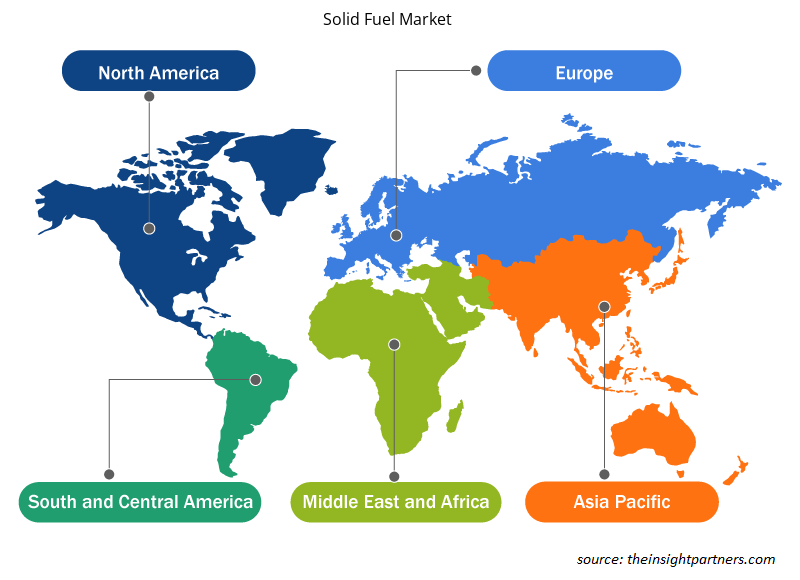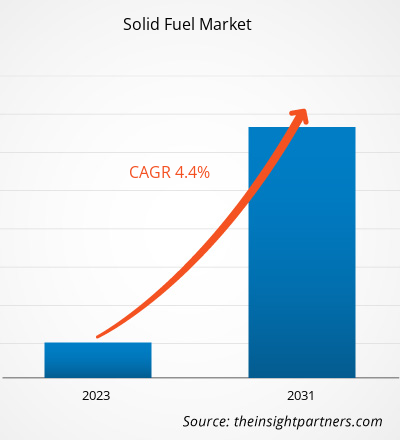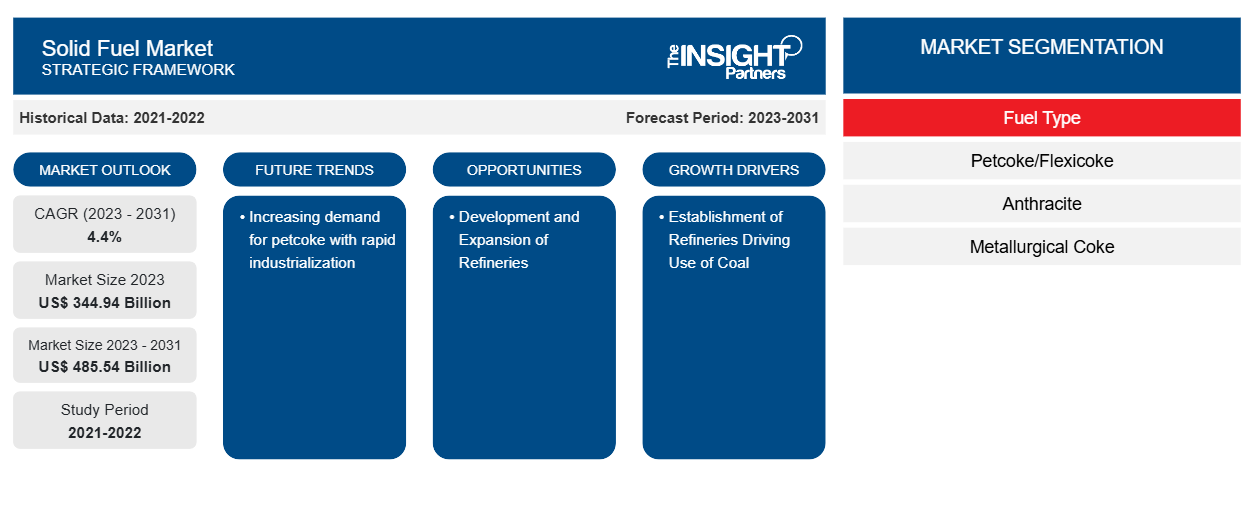Se proyecta que el tamaño del mercado de combustibles sólidos alcance los 485.540 millones de dólares en 2031, frente a los 344.940 millones de dólares en 2023. Se espera que el mercado registre una CAGR del 4,4 % durante el período 2023-2031. Se espera que la creciente demanda de coque de petróleo con la rápida industrialización siga siendo una tendencia clave en el mercado.
Análisis del mercado de combustibles sólidos
Se prevé que el uso de carbón en diferentes industrias en todo el mundo impulse el crecimiento del mercado durante el período de pronóstico. Además, se prevé que un aumento en el desarrollo o establecimiento de refinerías de petróleo y gas impulse el crecimiento del mercado de combustibles sólidos durante el período analizado . Sin embargo, las regulaciones gubernamentales para reducir las emisiones de carbono y la disponibilidad de sustitutos del carbón son los principales factores restrictivos que obstaculizan el crecimiento del mercado de combustibles sólidos en los próximos años. Además, se prevé que el desarrollo y la expansión de las refinerías y el aumento de la demanda de combustibles sólidos impulsen el crecimiento del mercado de 2023 a 2031.
Panorama general del mercado de combustibles sólidos
La creciente demanda de combustibles sólidos para la generación de electricidad y de la industria de combustibles para el transporte impulsa el crecimiento del mercado de combustibles sólidos. La electricidad se utiliza en una amplia gama de propósitos domésticos, comerciales e industriales. Con el paso de los años, el uso de electricidad ha aumentado. Según los datos de la Administración de Información Energética de EE. UU. publicados en 2023, el consumo total de electricidad en EE. UU. fue de 4,07 billones de kWh en 2022, lo que fue 14 veces mayor que el uso de electricidad en 1950. Por lo tanto, el uso creciente de electricidad está impulsando el crecimiento del mercado de combustibles sólidos.
El acero se utiliza cada vez más en todas las industrias, ya que es el material más importante para la fabricación de componentes utilizados en automóviles, utensilios, productos de construcción, refrigeradores, lavadoras y otros electrodomésticos. Además, el coque de petróleo se utiliza como materia prima para producir acero. Durante la producción de acero, se produce una torta de metal . Por lo tanto, la creciente industria del acero impulsa la demanda de coque de petróleo y produce coque de petróleo que se puede utilizar en los procesos de la industria siderúrgica , lo que impulsa el crecimiento del mercado de combustibles sólidos.
Personalice este informe según sus necesidades
Obtendrá personalización en cualquier informe, sin cargo, incluidas partes de este informe o análisis a nivel de país, paquete de datos de Excel, así como también grandes ofertas y descuentos para empresas emergentes y universidades.
-
Obtenga las principales tendencias clave del mercado de este informe.Esta muestra GRATUITA incluirá análisis de datos, desde tendencias del mercado hasta estimaciones y pronósticos.
Factores impulsores y oportunidades del mercado de combustibles sólidos
La creación de refinerías impulsa el uso del carbón para favorecer el mercado
Las refinerías de petróleo del mundo se utilizan para producir una variedad de productos finales, entre ellos gasolina, ánodos de carbono, combustible de aviación y combustible para calefacción. El creciente establecimiento de refinerías de petróleo en el mundo resultó en un aumento de la demanda de carbón como recurso energético. Cuatro de las diez mayores empresas de refinación de petróleo del mundo están en Asia, mientras que tres están en América del Norte y otras empresas de refinación de petróleo están en Europa. Estados Unidos, China, Rusia e India tienen las mayores capacidades de refinación de petróleo del mundo. Asia Pacífico es un refugio que tiene el mayor número de refinerías de petróleo operativas. Había alrededor de 310 refinerías de petróleo operativas en la región en 2021. Debido a la creciente demanda de potencias económicas como India y China, aproximadamente 90 instalaciones de refinación se encuentran en una fase de planificación o de trabajo en curso (construcción).
Desarrollo y Expansión de Refinerías
En junio de 2022, el informe sobre el mercado petrolero de la AIE predijo que la capacidad neta de refinación global se expandiría en 1,6 millones de b/d adicionales en 2023. La expansión o el crecimiento de la nueva capacidad de refinación consiste en varios proyectos de refinación de alta capacidad en marcha, especialmente en Oriente Medio y China. La región antes mencionada y el país tienen el potencial de agregar más de 4,0 millones de b/d de nueva capacidad en los próximos dos años.
- En China, se proyecta que la capacidad general tendría un efecto de bola de nieve debido al inicio de un mínimo de dos nuevos proyectos de refinería y una importante expansión de refinería.
- En Oriente Medio se amplió en 2021 una importante capacidad de refinación. En Arabia Saudita, la refinería de Jizan, con una capacidad de 400.000 b/d, entró en funcionamiento a finales de 2021 y comenzó a exportar productos petrolíferos a principios de 2022.
- Se estima que se pondrá en marcha una nueva refinería con una capacidad de más de 2 millones de b/d para ayudar a los mercados de la cuenca del océano Índico. Junto con esto, está previsto otro proyecto importante en la cuenca atlántica. Una vez completado el proyecto mencionado, una refinería de 650.000 b/d de Dangote Industries en Lagos (Nigeria) será la más grande del país. El desarrollo de una refinería satisfaría la demanda de petróleo de los países africanos vecinos y del país.
Por lo tanto, la expansión de las refinerías aumentaría el uso de combustibles sólidos, lo que se espera que ofrezca oportunidades lucrativas para el mercado de combustibles sólidos durante el período de pronóstico.
Análisis de segmentación del informe del mercado de combustibles sólidos
El segmento clave que contribuyó a la derivación del análisis del mercado de combustibles sólidos es el tipo de combustible.
- Según el tipo de combustible, el mercado de combustibles sólidos se divide en coque de petróleo/coque flexible, antracita, coque metalúrgico y carbón. El segmento del carbón tuvo una mayor participación de mercado en 2023.
Análisis de la cuota de mercado de combustibles sólidos por geografía
El alcance geográfico del informe del mercado de combustibles sólidos se divide principalmente en cinco regiones: América del Norte, Asia Pacífico, Europa, Medio Oriente y África, y América del Sur y Central.
Asia Pacífico lidera el mercado. Según el país, el mercado de combustibles sólidos en Asia Pacífico se clasifica en Australia, China, India, Japón, Corea del Sur y el resto de Asia Pacífico. Asia Pacífico tiene la presencia de muchos productores de coque de petróleo, lo que impulsó el crecimiento del mercado durante el período analizado. China es uno de los países destacados en el mercado de combustibles sólidos en Asia Pacífico. La región tiene una fuerte producción de carbón, ya que es una fuente muy esencial para la producción de energía, lo que puede aumentar la demanda de carbón en la región, lo que a su vez se espera que impulse el crecimiento del mercado entre 2023 y 2031. Hay un aumento en la producción de acero en la región de Asia Pacífico. La Asociación Mundial del Acero declaró en diciembre de 2022 que Asia y Oceanía produjeron 101,4 Mt de acero en noviembre de 2022, un aumento del 2,7% en comparación con noviembre de 2021. Además, según los datos del Ministerio de Acero de la India publicados en diciembre de 2022, la producción nacional de acero aumentó a 78,09 Mt en el año fiscal 2022 desde 73,02 Mt en el año fiscal 2021, con un aumento del 6,9%. Como la antracita se utiliza en el proceso de fabricación de acero, el aumento de la producción de acero impulsará la demanda de antracita, lo que, a su vez, se espera que impulse el mercado de combustibles sólidos en los próximos años.
Perspectivas regionales del mercado de combustibles sólidos
Los analistas de Insight Partners explicaron en detalle las tendencias y los factores regionales que influyen en el mercado de combustibles sólidos durante el período de pronóstico. Esta sección también analiza los segmentos y la geografía del mercado de combustibles sólidos en América del Norte, Europa, Asia Pacífico, Oriente Medio y África, y América del Sur y Central.

- Obtenga los datos regionales específicos para el mercado de combustibles sólidos
Alcance del informe sobre el mercado de combustibles sólidos
| Atributo del informe | Detalles |
|---|---|
| Tamaño del mercado en 2023 | US$ 344,94 mil millones |
| Tamaño del mercado en 2031 | US$ 485,54 mil millones |
| CAGR global (2023 - 2031) | 4,4% |
| Datos históricos | 2021-2022 |
| Período de pronóstico | 2023-2031 |
| Segmentos cubiertos |
Por tipo de combustible
|
| Regiones y países cubiertos |
América del norte
|
| Líderes del mercado y perfiles de empresas clave |
|
Densidad de actores del mercado: comprensión de su impacto en la dinámica empresarial
El mercado de combustibles sólidos está creciendo rápidamente, impulsado por la creciente demanda de los usuarios finales debido a factores como la evolución de las preferencias de los consumidores, los avances tecnológicos y una mayor conciencia de los beneficios del producto. A medida que aumenta la demanda, las empresas amplían sus ofertas, innovan para satisfacer las necesidades de los consumidores y aprovechan las tendencias emergentes, lo que impulsa aún más el crecimiento del mercado.
La densidad de actores del mercado se refiere a la distribución de las empresas o firmas que operan dentro de un mercado o industria en particular. Indica cuántos competidores (actores del mercado) están presentes en un espacio de mercado determinado en relación con su tamaño o valor total de mercado.
Las principales empresas que operan en el mercado de combustibles sólidos son:
- Corporación de petróleo de la India Ltd.
- Compañía Helénica de Petróleo Elinoil SA
- RESORBENTE Srl
- JH CARBON PTY LTD
- Corporación Chevron
- Compañía Phillips 66
Descargo de responsabilidad : Las empresas enumeradas anteriormente no están clasificadas en ningún orden particular.

- Obtenga una descripción general de los principales actores clave del mercado de combustibles sólidos
Noticias y desarrollos recientes del mercado de combustibles sólidos
El mercado de combustibles sólidos se evalúa mediante la recopilación de datos cualitativos y cuantitativos a partir de investigaciones primarias y secundarias, que incluyen publicaciones corporativas importantes, datos de asociaciones y bases de datos. A continuación se enumeran algunos de los avances en el mercado de combustibles sólidos:
- Petróleos de Venezuela, SA (PDVSA) firmó dos contratos con Latif Petrol y Reussi Trading. Mediante estos acuerdos, PDVSA exportará aproximadamente 1,6 millones de toneladas métricas de coque de petróleo. (Fuente: PDVSA, Nota de Prensa, julio de 2023)
- La refinería de petróleo SOCAR Star aumentó la producción de coque de petróleo en un 23,7 % en octubre de 2023. Esto ha ampliado la capacidad de producción de la refinería en el mercado de coque de petróleo. (Fuente: Refinería de petróleo SOCAR Star, comunicado de prensa, diciembre de 2023)
Informe sobre el mercado de combustibles sólidos: cobertura y resultados
El informe “Tamaño y pronóstico del mercado de combustibles sólidos (2021-2031)” proporciona un análisis detallado del mercado que cubre las siguientes áreas:
- Tamaño del mercado de combustibles sólidos y pronóstico a nivel mundial, regional y nacional para todos los segmentos clave del mercado cubiertos bajo el alcance
- Tendencias del mercado de combustibles sólidos, así como dinámicas del mercado, como impulsores, restricciones y oportunidades clave
- Análisis PEST y FODA detallados
- Análisis del mercado de combustibles sólidos que abarca las tendencias clave del mercado, el marco global y regional, los principales actores, las regulaciones y los desarrollos recientes del mercado.
- Análisis del panorama de la industria y de la competencia que abarca la concentración del mercado, el análisis de mapas de calor, los actores destacados y los desarrollos recientes del mercado de combustibles sólidos
- Perfiles detallados de empresas
- Análisis histórico (2 años), año base, pronóstico (7 años) con CAGR
- Análisis PEST y FODA
- Tamaño del mercado, valor/volumen: global, regional y nacional
- Industria y panorama competitivo
- Conjunto de datos de Excel
Informes recientes
Testimonios
Razón para comprar
- Toma de decisiones informada
- Comprensión de la dinámica del mercado
- Análisis competitivo
- Información sobre clientes
- Pronósticos del mercado
- Mitigación de riesgos
- Planificación estratégica
- Justificación de la inversión
- Identificación de mercados emergentes
- Mejora de las estrategias de marketing
- Impulso de la eficiencia operativa
- Alineación con las tendencias regulatorias























 Obtenga una muestra gratuita para - Mercado de combustibles sólidos
Obtenga una muestra gratuita para - Mercado de combustibles sólidos